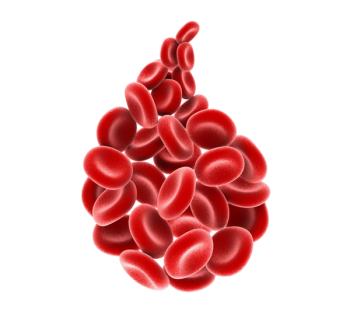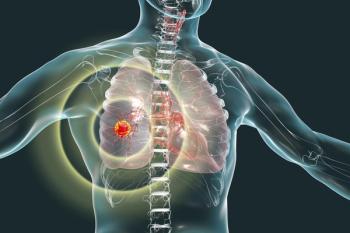
ROS1-Targeting Therapies Show “Suboptimal” Efficacy in ROS1-Mutated NSCLC
Although survival outcomes were numerically improved with ROS1-targeted therapies, an unmet need remains for patients with ROS1-mutated advanced NSCLC.
Despite an observed numerical improvement in survival outcomes, ROS1-targeting therapies exhibited suboptimal efficacy vs non–ROS1-targeting therapies in treating patients with ROS1-mutated advanced non–small cell lung cancer (NSCLC), according to data from a real-world study presented at the
For all patients in the study who received the standard available care for ROS1-positive advanced NSCLC (n = 103), the median real-world progression-free survival (rwPFS) was 9.6 months (95% CI, 8.3-14.0). The median overall survival (OS) was 38.9 months (95% CI, 27.2-61.6) for this patient population.
Furthermore, among patients treated with targeted therapy for ROS1-mutated disease (n = 65), the median rwPFS was 14.0 months (95% CI, 8.3-19.8), with a 1-year rwPFS rate of 52% (95% CI, 41%-66%). For those treated with nontargeted therapies (n = 38), the median rwPFS was 9.0 months (95% CI, 7.5-11.0), with a 1-year rate of 23% (95% CI, 13%-42%).
Additionally, the median OS among patients treated with targeted therapies was 47.9 months (95% CI, 27.3-not estimable), with respective 1- and 3-year OS rates of 76% (95% CI, 67%-88%) and 59% (95% CI, 48%-74%). Among those treated with nontargeted therapies, the median OS was 29.3 months (95% CI, 17.7-65.7), with a 1-year OS rate of 78% (95% CI, 66%-93%) and a 3-year OS rate of 45% (95% CI, 30%-66%).
“There was a tendency for numerically longer survival in patients receiving [first-line] targeted therapy than in those receiving [first-line] nontargeted therapy,” lead investigator Christos Chouaid, MD, head of the Department of Pneumonology and Thoracic Oncology at the Centre Hospitalier Intercommunal de Créteil in France, wrote in the presentation with study coinvestigators. “Nevertheless, the observed rwPFS of 14 months and OS of [approximately] 48 months…are unsatisfactory, especially considering the relatively young age of this ROS1-positive population (median age, 57 years).”
The observational cohort study utilized secondary data pooled from patient electronic medical records across 9 clinical sites in Canada and across Europe, included in the Oncology Evidence Network. Those enrolled included adult patients with advanced NSCLC, defined as those with de novo diagnosis of locally advanced or metastatic disease or recurrent disease after initial diagnosis at stages I to III with confirmed ROS1-mutated disease. Patients diagnosed with advanced NSCLC between 2009 and 2023 were followed until death or end of study period.
Among all patients included in the study (n = 108), the median age was 57 years (range, 28-89). A total of 63.0% of patients were female, 98.1% had nonsquamous histology, and 82.4% had stage IV disease at initial diagnosis. Additionally, most patients included had a diagnosis of advanced disease between 2017 and 2023 (83.3%), an ECOG performance status of 0 to 1 (58.3%), no history of smoking (53.7%), and no brain, liver, or bone metastases (54.6%).
The most common first-line targeted therapies included crizotinib (Xalkori) monotherapy (43.7%), combinations with crizotinib (9.7%), and entrectinib (Rozlytrek) monotherapy (8.7%). Patients treated with nontargeted therapy often received platinum-based chemotherapy (25.2%) or an anti–PD-(L)1 immune checkpoint inhibitor with chemotherapy (6.8%). Among 65 and 38 patients treated with targeted and nontargeted therapies, respectively, 44 and 18 received second-line therapies and 33 and 9 received third-line therapies.
Among patients treated with systemic anticancer therapies for ROS1-mutated disease, rwPFS and OS were described using the Kaplan-Meier method, with an index date starting at the receipt of first-line treatment. Among subgroups comprised of fewer than 20 patients, both the Kaplan-Meier curve and median value were suppressed, with curves truncated when the number of patients was below 10.
Chouaid and investigators noted that the data interpretation could be affected due to the small sample size of the study population. Additionally, they acknowledged that secondary data used from electronic medical records could have been subject to point-of-care data entry errors not detected or corrected during the analyses.
Disclosures: Chouaid reported consulting fees from Daiichi Sankyo and Pierre Fabre and consulting fees and travel support from Amgen, AstraZeneca, Bayer, Boehringer Ingelheim, Bristol Myers Squibb, GSK, Lilly, MSD, Novartis, Pfizer, Roche, Sanofi Aventis, and Takeda.
Reference
Chouaid C, Lee A, Bote de Cabo H, et al. Real-world treatment patterns and survival in patients (pts) with ROS1-positive (ROS1+) locally advanced or metastatic (LAM) non-small cell lung cancer (NSCLC) in Canada and Europe. Poster presented at: European Society for Medical Oncology Congress 2025; October 17-21, 2025; Berlin, Germany. Poster 1988P.
Newsletter
Stay up to date on recent advances in the multidisciplinary approach to cancer.


















































































